 Are you thinking about setting up an e-commerce website or selling goods to an international audience? If so, you should think about providing your web visitors with currency conversion.
Are you thinking about setting up an e-commerce website or selling goods to an international audience? If so, you should think about providing your web visitors with currency conversion.
Currency conversion allows your visitors to have the price of a foreign currency transaction converted to their local currency at the purchase or checkout stage. It also lets visitors view the exact amount their credit card or PayPal account will be charged, expressed in their own home currency.
One great benefit of putting currency conversion on your site is that it allows customers to view and understand prices in foreign countries in their own home currency, and makes it easier for visitors to work out their costs and expenses.
Fortunately, if you are a WordPress user, you can add a currency converter to currency conversion to WordPress using a plugin, allowing your prospective customers to quickly work out the cost of your products.
Currencyr
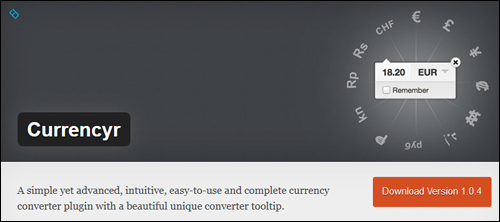
Currencyr is an intuitive, easy-to-use and complete currency converter plugin with a unique and attractive converter tooltip. Best of all, it’s free to install and use on your WordPress website or blog.
The Currencyr useful WP plugin includes advanced features like the following:
- In-line converter
- Supports several exchange rates providers, like Yahoo!, Open Exchange Rates and FoxRates
- Support database cache driven for fast response
- Currency table and converter widget
- Can be integrated with a number of online store plugins like WP-eCommerce & Shopp.
- Automatic local currency determination
- Full language translation support
Note: This plugin needs PHP 5.3.0 or later. Do not install this plugin if you currently have an older version of PHP installed on your server. Ask your web host to upgrade your PHP.
***
You can install the plugin from your WordPress dashboard by typing in “currencyr” into the Plugins search field and clicking “Install Now” …
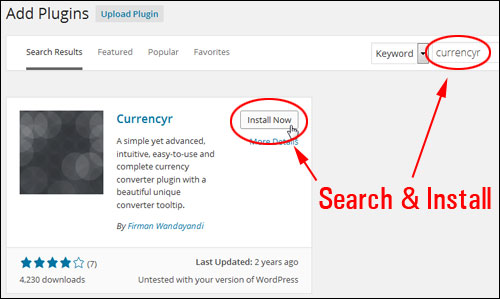
After installing and activating the plugin, you can visit the plugin’s settings by choosing Currencyr from your WordPress admin user area …
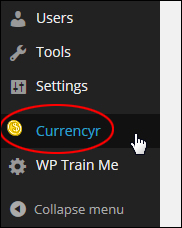
This takes you to the plugin settings screen …
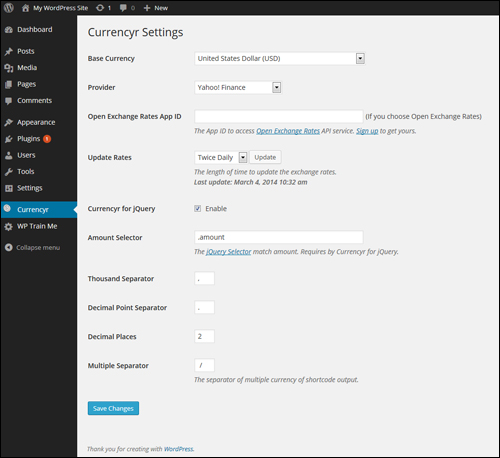
For example, you can choose a base currency from the ‘Base Currency’ drop-down menu if you prefer to use something other than the default option ’US Dollar’ …
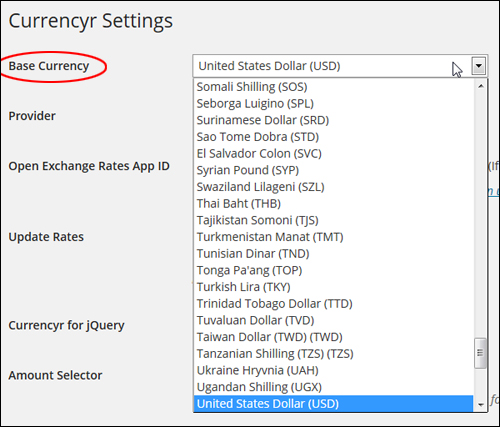
Similarly, you can specify which data provider you want to use from the dropdown menu in the ‘Provider’ section. The default provider is ‘Yahoo! Finance’, but you can also choose one of the other options, like European Central Bank, FoxRate, Google Finance or Open Exchange Rates …

Note: If you choose ‘Open Exchange Rates’, an API (Application Programming Interface) will be required …

You can specify how frequently you would like to update the exchange rates by selecting an option from the ‘Update Rates’ dropdown menu …

The Currencyr plugin uses jQuery, which allows web developers to add things like animation effects to web applications (e.g. WordPress plugins).
Unless you have a reason to edit the jQuery settings, leave this option alone …

Edit the rest of the plugin settings to suit your own preferences and don’t forget to click the ‘Save Changes’ button when done …

After your plugin settings have been configured, you can add currency conversion to any WordPress post using shortcodes.
Refer to the ‘Additional Plugin Notes’ section below to learn how to use currency codes (e.g. USD, GBP, JPY, etc …) with this plugin.
Using Shortcodes
You can easily insert currency conversion into pages, posts and widgets without touching your web templates using shortcodes.
Below are some examples of currency shortcodes that you can add to posts and pages:
Let’s say that you retail an item on your site for a set price (e.g. $175) in US Dollars (USD), and you want to display your conversion amount in British pounds (GBP) on your sales page.
All you need to do is insert the following shortcode to your post or page …

Note: You can also insert pricing in dollars and cents (e.g. 6.95, 47.00, 544.97, etc …)
The example below shows how the shortcode looks after you have inserted it into a page or post …

After publishing the information, the currency conversion will display as seen in the screenshot below …
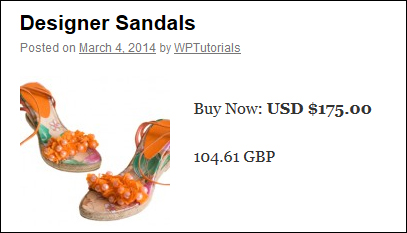
Using the above example, let’s now translate the same amount into multiple currency formats.
To do this, use following shortcode (you can add as many currency symbols as you want separated by vertical pipes) …

The example below shows how the shortcode appears when added to a post …

Once your page or post has been published, your currency conversion will then display as you can see in the example below …
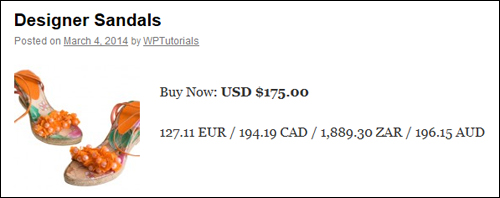
See the ‘Additional Plugin Notes’ section at the bottom of this tutorial to learn how to change the currency separator symbol in the Currencyr plugin.
Now, suppose you want to select a different base currency than the one selected as the default.
For example, if you have set your default base currency as EUR and you have a section on your website targeted to visitors in countries like Australia or Canada, you can change the base currency using the following shortcode …

You can see how the shortcode appears when added to a page …

After publishing your information, the converted currency will then appear like this …

Widget
You can also add a currency converter to your website or blog’s sidebar using a widget.
To add currency conversion to your sidebar, select Appearance > Widgets from the WordPress dashboard menu …
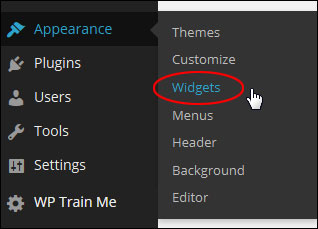
In the Widgets > Available Widgets section find the ‘Currencyr’ widget and add it to an ‘Active Widgets’ location …
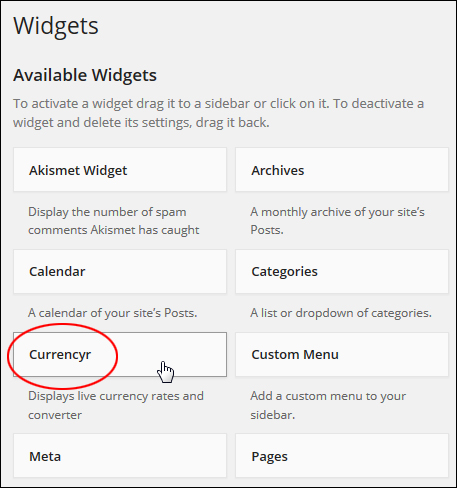
Configure the widget settings as shown in the example below (add currency codes separated by a comma), and click Save to update your settings …
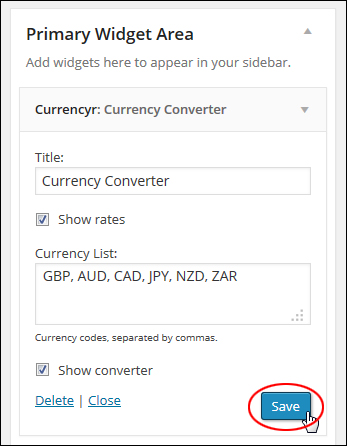
Your currency converter will now display on your sidebar with the options you have selected …
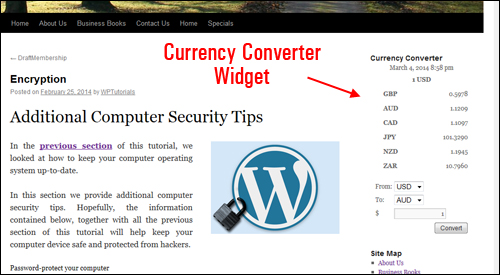
Additional Plugin Notes
Here are some additional notes and useful information about using the Currencyr plugin.
Currency Separator
The Currencyr plugin allows you to specify the symbol to display as the currency separator when using multiple currencies.
You can select a different symbol in the ‘Multiple Separator’ settings section.
So, for example, using the default symbol “/” (forward slash) …

Displays your currency values separated by the forward slash as you can see in the example below …
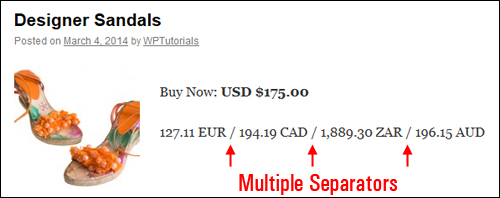
If you enter another symbol and update your plugin settings …

Your site visitors will see the new symbol used as the currency separator …
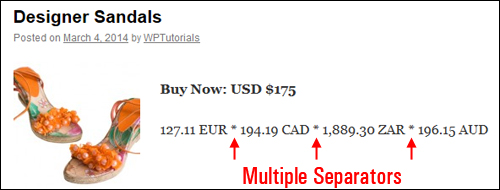
Using The Plugin With WordPress-Compatible e-Commerce Platforms
As mentioned earlier, the Currencyr plugin can be integrated with various WordPress-compatible e-commerce plugins such as WooCommerce, WP-eCommerce and Easy Digital Downloads …
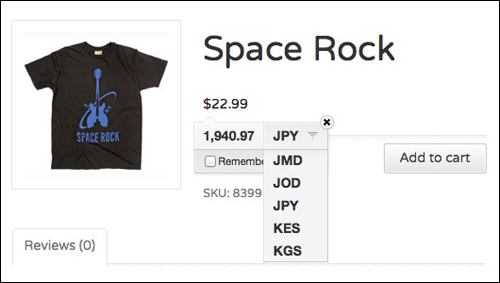
(image source: Currencyr plugin site)
And there you have it! Now you can go and easily add a currency converter to your e-commerce site.
To learn more about WordPress e-commerce plugins, see the tutorial below:
***
"This is an awesome training series. I have a pretty good understanding of WordPress already, but this is helping me to move somewhere from intermediate to advanced user!" - Kim Lednum